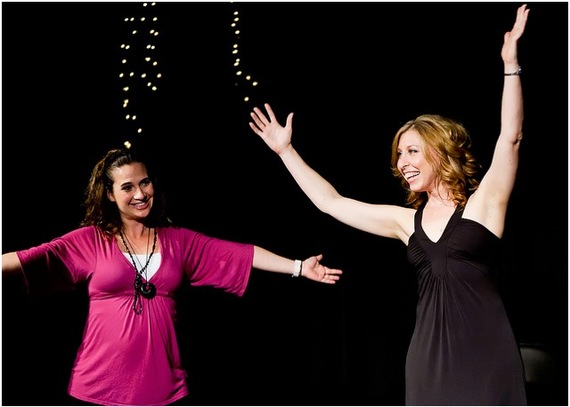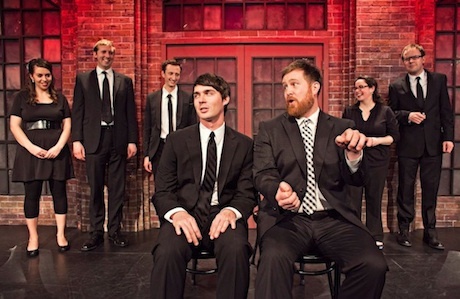Picture it. You've prepped for that important presentation... you've gotten stakeholder buy-in, triple-checked your numbers. YOU ARE READY. You walk into the executive boardroom, exchange pleasantries, and are immediately crushed: the budget has been cut, your allotted time has been squeezed, the VP has been called out to another meeting.
Rats.
It's okay. You've got this. Why?
Because you've practiced failing.
(Wait... what?)
Ten years ago I signed up for my first Improv class. I was looking forward to meeting people, having fun and scratching the acting itch. What I didn't expect was that Improv would immeasurably prepare me for the roller coaster of Corporate America.
Instilling both a sense of confidence and agility, Improv helps professionals become better communicators, partners and leaders. Here are the top 4 lessons I've learned:
Lesson #1: Learn how to fail.
It was my first day of class. Our instructor asked us to circle up for a name game. Recalling cheesy ice breakers of the past I groaned. However, as soon as the game started I awoke. Our vivacious teacher kept it dynamic. Within minutes we were tasked with new obstacles: passing a squishy ball, copying intricate hand signals, reversing directions. As the stakes increased, so did the rewards. We were driven.We could taste success. None of us wanted to drop the ball (literally or figuratively).
And then suddenly our teacher stopped the game. She added one more element - the Failure Bow:
- When someone messed up, the game would stop
- The person who messed up would give an over-the-top-theatrical bow, admitting "I FAILED"
- Everyone would applaud their mistake.
(Wait... what? People would clap? For our mistakes?)
Yes!
So we each practiced our failure bow. Sure, we felt silly. But we quickly accepted that it was a part of the game. (After all, we wanted to get back to the fun.)
Then something interesting happened. With each mistake, the bows got more and more creative. Gentle curtsies morphed into giant swan dives. In fact, the more dramatic the bow, the bigger the applause (and laugh). Easing up, we recognized that it WAS okay to fail. It was a part of the process.
And guess what? As a result, we ended up taking more risks. Our class passed the ball faster, we chanted names louder, we nailed the hand signals. And when we messed up? No problem. There was something very therapeutic about letting go, saying "okay, I goofed up...so what... let's move on." Still not convinced? There's even a TEDx about the failure bow.
By establishing a safe environment to fail, our teacher encouraged us to take more risks. Not a bad thing, eh?
Lesson #2: "Yes And."
Think about a fast brainstorming session in which you participated. It was fun, right? When correctly facilitated, rapid brainstorms can be a welcome departure from the mundane. As people piggyback off others' ideas, the exercise can be effective. Why? Because no idea is shut down.
Yes! We SHOULD launch an underwater-basket-weaving-service!
(Okay, maybe that's a little drastic.)
In Improv this acceptance is called "Yes And." By saying these two words (yes... and), stories rapidly evolve as improvisers add on to others' suggestions:
~Let's go to the beach!
~ Yes! And I'll bring the chairs...
~ Yes, and I will pack the lunches!
~ And we can stop for ice cream on the way back home!
Sounds like a fun trip, right? Such fast-paced interactions weave an interesting story. Having been provided the arena in which to fail, improvisers feel more comfortable trying new things, throwing out new ideas, taking more risks. And by piggybacking off others' ideas we craft even bigger, better, more innovative ideas. Win - win, right?
Note: this isn't to say that spontaneity should trump proper planning/analysis/data-crunching; however, what do you think would happen if you intentionally said a few more yes's (than no's) each day?
Lesson #3: Make your partner look good.
Equally important as "Yes And" is the notion of partnership -- specifically, making your partners look good. Let's return to the previous scenario, this time using "No" instead of "Yes":
~Hey, let's go to the beach!
~No. You hate the water and we will never find parking.
Waaa waaah. Boring, right? This use of No is called a "block" in Improv -- and it's very hard to rebound from this situation. The second person has negated the first person's offer, interrupting the flow and causing cognitive dissonance. (We are confused: Why would the first person offer to go to the beach if s/he didn't like the water?) Whether on stage or in the audience, this is a buzzkill.
On the flip side, generous partners continue the thread, further crafting the plot and detailing the characters' idiosyncrasies:
>~Hey! Let's go the beach!
~Yes! Let's take your car because it has more room and you have better music...
~And we can grab lunch on our way out there.
~Sounds great... I know a great vegan restaurant that you'll love, etc.
In this scenario the improvisers accept the offers, adding unique twists to make the scenes even better.
What could you do today -- to make others look better?
Lesson #4: COMMIT.
Gymnasts "stick" their landings. Game show contestants confirm "that's my final answer." Likewise, improvisers commit to characters, scenes, stories. Having already mastered the art of the fail, improvisers feel comfortable in taking risks. (They know they have each other's back: "Break a leg!'') The next logical step is execution, aka sticking the landing. Returning to our beach scene, it looks something like this:
~Hey let's go to the beach!
~Yes! Let's take your car... (pretend to open an imaginary car door)
~Wow, you've got some great music in here (opening up the glove box), etc.
The audience can "see" the scene. They envision the car, the steering wheel, the seats. By committing to the idea and details, the beach comes to life: the audience swears they can even "hear" the seagulls.
Stick your landing.
So let's return to that executive boardroom. Direction has changed, all eyes are on you. How will you react? Do you freeze up? Do you scamper out of the room? Nope. Improv has prepared you for this: You acknowledge the change in direction, knowing that you can leverage work already created (you're agile). You reference the team's hard work...(you're generous). You devise next steps and yes, you stick your landing.
You're calm, you're confident...(you're even having fun. Gasp!)
Thank goodness you had practiced that fail...
What about you? Have you ever taken an improv class? How did it help you in business?
-------------------------
Jennie works in Marketing and can be found on Twitter @jenniesuth. Huge thanks to the BEST improv teachers: Shana Merlin at Merlin-Works and Mary Jane Pories at Fishladder. Check out their work!
Images: Flickr Common, theartofchange.com, Groupon (Second City)
This post originally appeared in the #bestadvice section on LinkedIn




